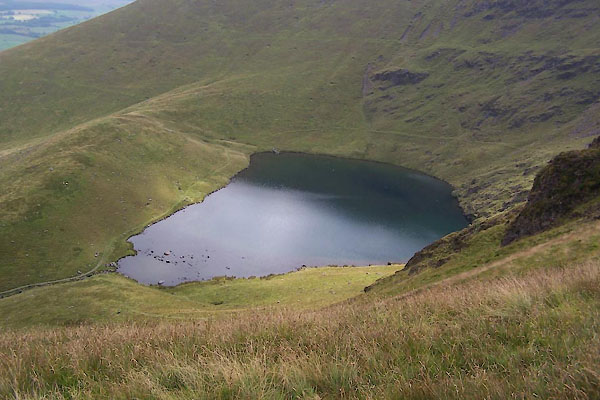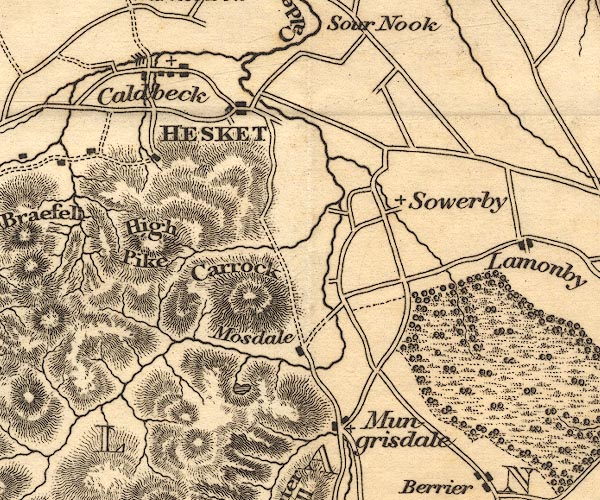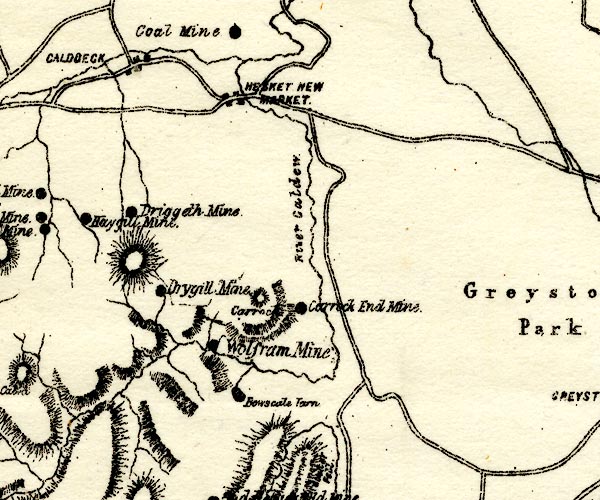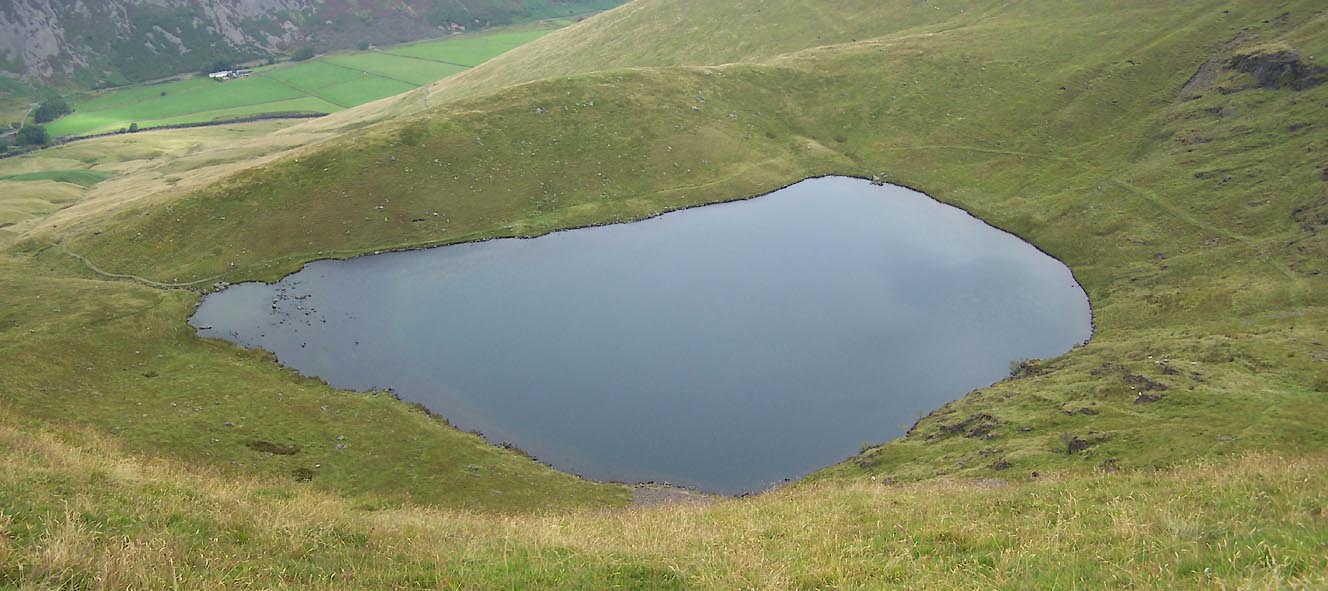




 Tarn Sike (2)
Tarn Sike (2)
BVC96.jpg (taken 3.8.2011)

Click to enlarge
BVC98.jpg (taken 3.8.2011)
placename:- Bowscale Tarn
placename:- Bouscale Tarn
item:- stars at midday
 goto source
goto sourceGentleman's Magazine 1747 p.523 "[on a journey to Caldbeck Fells] ..."
"[River Caldew] ... receives a small rivulet from Bouscale-tarn, a lake near a mile in circumference, on the side of a high mountain, so strangely surrounded with a more eminent amphitheatrical ridge of quarry rocks, that it is excluded the benefit of the sun for at least four months, in the middle of winter; but this is not its only singularity. Several of the most credible inhabitants thereabouts, affirming that they frequently see the stars in it at mid-day; but in order to discover that phaenomenon, the firmament must be perfectly clear, the air stable, and the water unagitated. These circumstances not concurring at the time I was there, depriv'd me of the pleasure of that sight, and of recommending it to the naturalists upon my own ocular evidence, which I regret the want of, as I question if the like has been any where else observed. The spectator must be situated at least 200 yards above the lake, and as much below the summit of the semi-ambient ridge; and as there are other high mountains, which in that position may break and deaden the solar rays, I can only give an implicit credit to the power of their agency, 'till I am convinc'd of their effects, and am qualified to send it better recommended to the publick."
placename:- Bouse Scale Tarn

GM1404.jpg
"Bouse scale Tarn"
outline, shaded; tarn; I have no other evidence of "Slate quarries"
marked here
item:- Carlisle Library : Map 43
Image © Carlisle Library
placename:- Bouscale Tarn
item:- stars at midday
 goto source
goto sourcePage 523:- "... Bouscale-tarn, a lake near a mile in circumference, on the side of a high mountain, so strangely surrounded with a more eminent amphitheatrical ridge of quarry rocks, that it is excluded the benefit of the sun for at least four months, in the middle of winter; but this is not its only singularity. Several of the most credible inhabitants thereabouts, affirming that they frequently see the stars in it at mid-day; but in order to discover that phaenomenon, the firmament must be perfectly clear, the air stable, and the water unagitated. These circumstances not concurring at the time I was there, depriv'd me of the pleasure of that sight, and of recommending it to the naturalists upon my own ocular evidence, which I regret the want of, as I question if the like has been any where else observed. The spectator must be situated at least 200 yards above the lake, and as much below the summit of the semi-ambient ridge; and as there are other high mountains, which in that position may break and deaden the solar rays, I can only give an implicit credit to the power of their agency, 'till I am convinc'd of their effects, and am qualified to send it better recommended to the publick."
placename:- Bowscale Tarn

D4NY33SW.jpg
"Bowscale Tarn"
lake
item:- Carlisle Library : Map 2
Image © Carlisle Library
placename:- Booth Scale Tarn
item:- Bosom Wind; wind
 goto source
goto sourcepage xxxix:- "..."
"The Bosom-Wind is quite a different affair, and takes place wherever one object in the direction of the wind overlooks another, or universally where any thing breaks the current of the air that would otherwise impinge directly on the objects beyond it; this is particularly the case where large rocks screen things below them from the direct force of the wind, yet subject them to what is called a Bosom-Wind. Near the sources of the Caldew is a valley called Swineside, never visited by the rays of the sun during the Winter months: on the northern side of the hill which overshadows it in this manner, and at a considerable height above the valley, is a pretty large bason of water, called Booth-scale-tarn; three fourths of which is surrounded either by an exceedingly steep heath, or by entire rocks, and the fourth, being the side right above the valley, gives an outlet to the water. A road leads from the low grounds to this lake, and from the outlet winds above half round it, gradually ascending to some rocks where are slate-quarries, on account of which it was first made; near these quarries the road is a considerable height above the lake, and the perpendicular height of the hill above it cannot be less than four hundred yards; on the other side of this height the descent is at an angle of perhaps fifty degrees, but on this at a much greater. On a wet and windy day, in Autumn, I once took a ride with two companions to this lake: the wind blew directly over the height which I mentioned, not striking upon us except in uncertain puffs, on account of the intervention of the hill; that is, the wind, inpinging on the inclined plane of the other side of the hill, was compelled, towards the summit of it, in an oblique direction, its powers continually increasing, and itself being more and more condensed by the addition of fresh air pressing on its course in a similar diverted manner. This current at the summit met with the regular wind, and after striking violently on the mass of air moving in higher regions, was, by means of a combination of the weight and motion of that air, at last repelled into the tranquil and stagnant air beneath, where there was not a resistance from motion, and thus occasioned the wind of which I am speaking. It was this wind which amused me very much at that time: I was looking at the lake beneath, and saw it grow black near the centre; the spot where this first appeared changed directly into a livid appearance, by being contrasted with the rest of the water, through which from this spot, as a fixed point, rolled concentric circles of waves towards the circumference in a tumultuous manner, whilst the centre itself remained quite smooth and undisturbed. The wind which produced this agitation immediately after ascended the sides of the bason, and affected us with very great force; I could also observe the heath on the other sides of the pool shook by the same, and in the same main direction from a centre very forcibly. Such was the effects that I observed: I am told, however, that others have known a wind of the same kind, in dry weather, snatch the water out of the pool, and scatter it as spray through the whole of this imprisoned space."
"..."

OT02NY33.jpg
Tarn SW of Mosdale.
item:- JandMN : 48.1
Image © see bottom of page
 goto source
goto sourcePage 38:- "Bowscale Tarn, which empties itself into the Caldew, is seated in a basin singularly scooped out in the side of a hill. ..."
placename:- Bowscale Tarn

GAR2NY33.jpg
"Bowscale Tarn"
outline with shore form lines, lake or tarn
item:- JandMN : 82.1
Image © see bottom of page
item:- stars at noon; fish, Scales Tarn; mathematics
 goto source
goto sourcePage 101:- "The other mountain-lake, lying north-east of this, and called Bowscale Tarn, is also reputed to reflect the stars at noonday, but under so many conditions, that it will be a wonder if any body ever has the luck to see them. It is in this tarn that, in the belief of the"
 goto source
goto sourcePage 102:- "country people, there are two fish which cannot die; - the same fish that used to wait on the pleasure of the good Lord Clifford when, in his shepherd days, he learned mathematics from the stars upon the mountain. ..."
placename:- Bowscale Tarn

PST2NY33.jpg
"Bowscale Tarn"
lake
item:- JandMN : 162.2
Image © see bottom of page

Click to enlarge
BWR04.jpg (taken 3.8.2011)

Click to enlarge
BVC97.jpg (taken 3.8.2011)

Click to enlarge
BVC99.jpg (taken 3.8.2011)
Smith, J: 1955 :: Journal of the Optical Society of America: vol.45: pp.482-
The surface of that sable tarn,
In whose black mirror you may spy
The stars, while noon-tide lights the sky."
